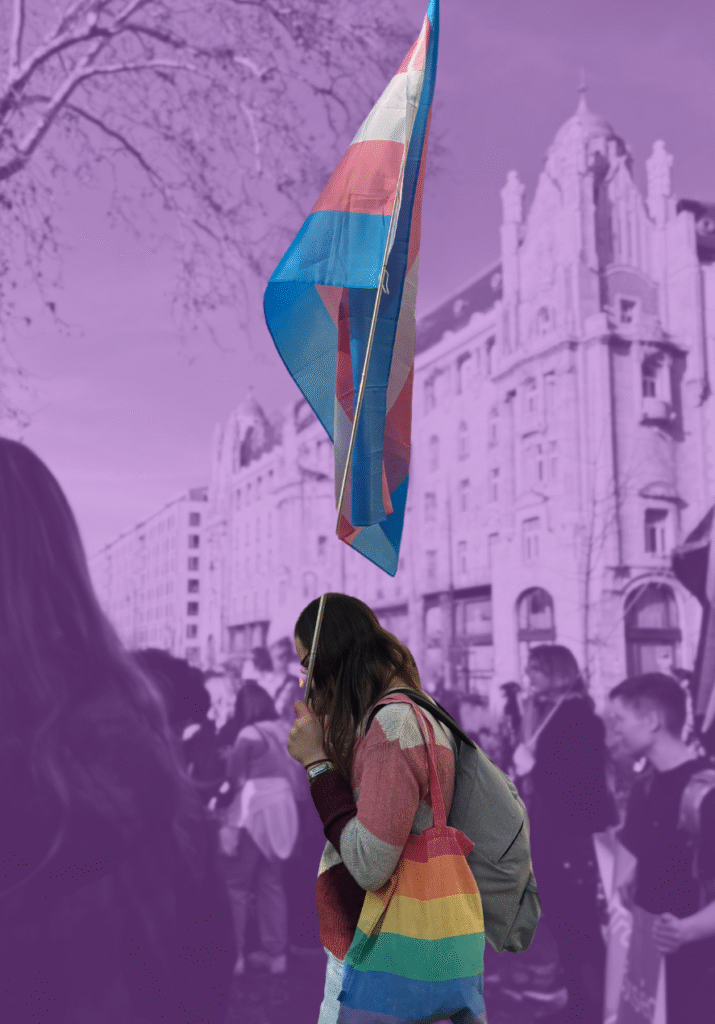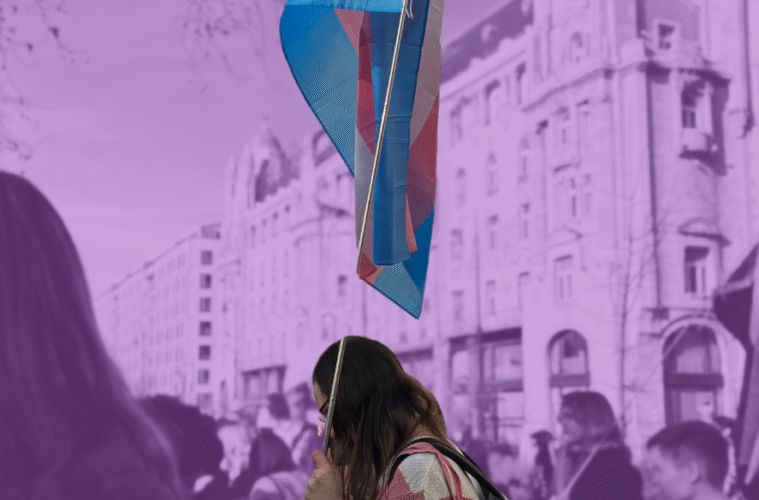I’m journaling, and there are bombs in my mind. The world is on fire, I know. And not in a good way. Here we are in front of the Cathedral. Someone has thrown a piece of fruit from a window -on purpose, I think. We’ve been walking some streets. Flags, pastel and vibrant colours are the weapons that represent a threat to many. Looking around is like remembering the parades from the past, but it’s not quite the same. It’s lugubrious.
In the 90’s, someone dared to publicly identify as both queer and Hungarian on the first pride parade, and take as theirs the identity of this country, by reappropriating the poetry of national heroes: “Édes hazám, fogadj szivedbe, hadd legyek …!” (My sweet homeland, take me to your heart—let me be/exist!).
If we think about reclaiming rights back, as every citizen should supposedly have the same freedoms in a democratic country, who would be to blame for seeking a home in words from József Attila or in the figure of Károly Mária Kertbeny? Both prominent exposers of Hungarian culture in its prime. It can be seen, rightfully, as a reconfiguration of cultural and political legitimacy, but in the universal search for identity and belonging, how can one feel safe without community? A shelter where to grow, express freely and simply exist without being filtered by repressive narratives.
Trying to find a way in the midst of the increasingly conservative rhetoric of the world, but especially now in Hungary, is a challenge that most see as a lost battle. Since March this year, the threat to the LGBTQAI+ movement has been escalated by the passing of a new legislation in Parliament that bans Pride and events related to it. This law was pushed through the legal channels and signed in less than 24 hours (talk about efficiency), and it essentially violates the rights of freedom of assembly and speech while encouraging discrimination.

Everything, everywhere, all at once: what’s happening on both sides
In the past weeks, there has been an organised protest scheduled for every Tuesday, and the occasional Saturdays in order to make a stand against this autocratic decision. Members of different political parties and various segments of the civil society have decided to raise their voices and defy this arbitrary law in different and creative ways, like the Gray Pride Demonstration, where protestors were wearing a shade of gray colours instead of the usual flamboyant ones, showing a satirical way of sending a message: “sameness is trendy”, making reference to the current government’s effort to silence voices of diversity and excluding those who pose a threat to their political agenda.
Today, many Hungarians have an unclear route on what can officially be done next from the opposition’s side, given that actions of civil resistance are the main hope to hold onto now. This also comes with the risk that there is someone waiting on the other side: a repressive state. Lately, raising your voice may come with a cost: some protesters can be detained, and others can be fined an amount of 200.000 HUF (almost 500 euros) on the spot.
The criminalisation of dissidents is real, even if it sounds crazy to even write the word “dissidents”, as in this case, it’s about gender, sexuality, and non-conforming stereotypes. But hey, we’re talking about personal narratives that shape the politics of a big puzzle, and are, therefore, consequences of the hegemonic nationalist ideologies of post-socialist Eastern Europe, where an ideal citizen is both heterosexual and reproductive, nothing beyond. As Renkins points out in his anthropology analysis, the options in the public narrative are limited: “if you are a nationalist, you are homophobic; if you are a homosexual, you are anti-national”, so it makes sense to use the word “dissident” if we follow the most conservative line of thought.
Are you pro-interest of your nation or are you a threat to it? There’s no in-between from the official standpoint. Oh, yeah, the sweet pillars of an incorruptible democracy, isn’t that right?
Some people are scared, others feel defiant. Facial recognition technology (FRT) and surveillance will be used in any gathering of this nature, to look for those who “violate” the law – ironically, a law that many lawyers still don’t quite understand in terms of practicality or applicability – by using symbols that can tie them to the LGBTQ+ movement: a rainbow, a flag, a sign, or even being dressed as something that the government considers inappropriate for “the gender you’re assigned at birth”. The way police can utilise FRT is by requesting a facial image analysis from the Hungarian Institute for Forensic Sciences (HIFS) and then passing on a report on the identity of the person through state databases.
All of this sounds dystopian, but to be fair, what doesn’t nowadays? Western administrations such as the US, which previously might have condemned and sanctioned Hungary’s brand of authoritarianism, are now subscribed to the same socially conservative agenda. This only serves to validate and empower the Hungarian government’s discriminatory choice to ignore and prosecute the reality of a modern and diverse society.
A society that is no less Hungarian than them, no matter their sexual orientation and/or gender identity, and that has as much right to belong in this land as a government who insists on keeping their binary goggles on.
Paris is still burning, so is Budapest
“Just be careful they don’t see you”. Dialogues go on and off in my head as I imagine the realities of the generations before us, meeting, afraid, at the former Egyetem Espresso café or at the Danube promenade during communist times and the period right after the fall of the Berlin Wall. The secrecy, the internal exile, the repression, all this hasn’t only affected the country in aspects of cultural identity, but also, in how freedom is viewed and what are the limits of it -as oxymoronic as it sounds- in this new era that we’re living.
It’s funny how we can think in pre, during and post chronological scenarios while reflecting on how those hiding in the underground were hoping the future would look like. I can picture some kind of diary, like the entries collected by Imrich Matyáš, and I mourn, even without knowing, the lost stories that vanished with the passing of time.
How can we voice those who fought and were erased from their own communities? How do we keep alive the flame of resistance and revolution in the name of equal justice for all?
While Hungary was still under socialism, the LGBTQAI+ movement was flourishing underground, especially in Budapest. This city has a very strong queer history, as it has been studied and remarked by professor Anita Kurimay in her book Queer Budapest: 1873-1961. The queer community has come from being criminalised – with emphasis on the male homosexual acts – passing through the switch of approach to a more institutionalised view based in the psychoanalysis, validating “reverse treatment” through therapy, as the goal was to “transform” Hungarian subjects into “ideal communist citizens” which were, of course, from the perspective of the communist experimental criminology department heterosexual, until the ultimate decriminalisation in 1961.

The first public lesbian/gay organization was founded in 1988, right on the verge of the end of the communist era. Several collectives joined after that, and even though some of them were denied official registration, they still resisted by splitting into small groups – talk about persistence! The first pride march started in 1997, whilst its attendance and popularity has grown significantly ever since. People from all over Europe come to this event, which has become a symbol of transnational resistance and identity for many.
In the middle of the angst and existential crises of today, personal essays of introspection are a key part to understanding those who were scared and hiding in the 80’s, or even before. They were supposed to not exist and, despite the passage of time, we are finding ourselves living in the same version of reality they were in those times, a suppressed society looking for alternatives to show that their mere existence is not a crime.
What happens next?
I wake up every morning wondering the exact same thing: what comes next. I know we’re in this continuous battlefield to find, or to even get a space, to construct a safe haven for ourselves and others. Thriving in community is harder when there’s a whole system against you. Targeted for who you are? In today’s world? Check. New regimes disguise as democracies, as old ones rebrand as saviours. The ones in power are taking the marketing strategies all the way up, redesigning conservative rethoric as if they were Pokémons and this was just another evolution. Instead of fantastical, powerful features in a harmless world, there is fascism, which is really the opposite, except for the powerful part. We know better than that.
Fortunately, in current times, the LGBTQAI+ collective in Budapest is strong, organized and very passionate about the defense of their rights. This is a very diverse and artistic city, with a legacy of resistance and a myriad of organisations working to make a difference that might threaten some in high power, and a portion of society that follows them, but inspires those who are scared of being who they are, freely. According to the organisers, the Budapest Pride March will still take place on June 28th, 2025, thus celebrating its 30th anniversary, and defying those who want to take away the spirit of freedom from not only a vulnerable community, but also from all the individuals who believe defending fundamental freedoms and human rights is not ideology but a duty in order to build a fair, equitable world.
Written and photos by María Cuéllar.
Engineer by profession, social sciences enthusiast, with a passion for multiculturalism and human rights advocacy.
Illustration by Juli Jásdi.
Juli Jásdi is a Budapest based Graphic Designer and freelance Illustrator. She graduated from the Hungarian University of Fine Arts in 2019. Her focus is on digital illustration, however, she is very much attracted to manual drawing. She likes experimenting with different ways of storytelling. Her narrative illustrations are quirky and bold, yet thought-provoking. Juli’s mission is not only pure entertainment, but also to grab attention and to raise awareness. You can see more of her work here.

